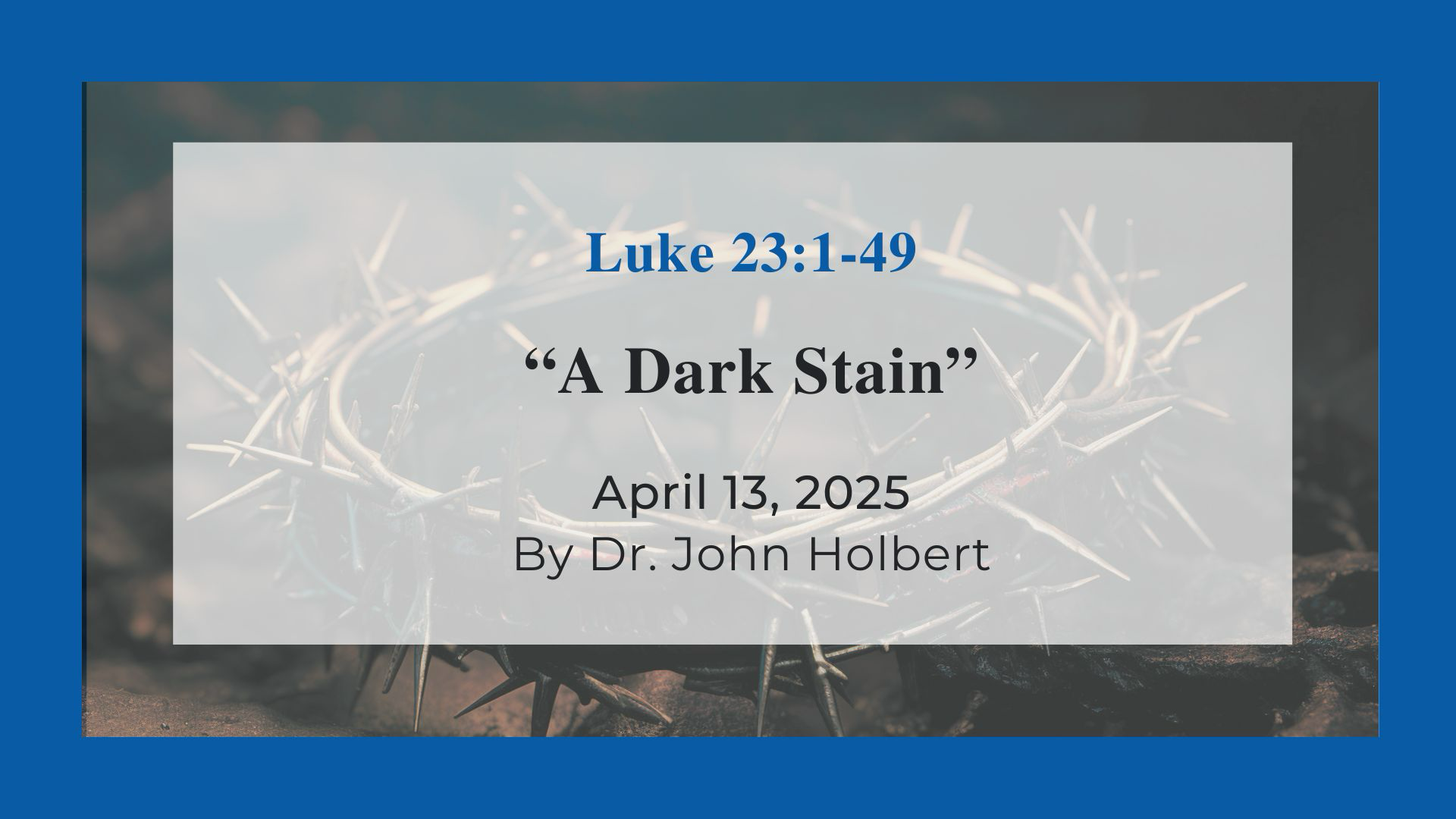"A Dark Stain" - Lectionary Reflections on Luke 23:1-49, Passion Sunday, Year C
by John C. Holbert on Thursday, February 13, 2025

No preacher or commentator would dare attempt a sermon or one brief essay on 49 closely argued and carefully written verses of any gospel text, let alone the famous and utterly dreadful account of the trials, condemnation, and crucifixion of Jesus. I propose in this short examination to look only at Luke 23:1-12, encompassing the narratives of Jesus’s confrontation with Pilate and Herod, instigated by the religious authorities who are bent on making the troublemaker disappear. As usual, Luke has his own unique ways of conveying that tale, and I will attempt to note those places when they occur.
Luke Timothy Johnson, in his 1991 commentary on Luke’s Gospel, notes that any Hellenistic person accustomed to stories of particularly noble endings of Greek philosophers, the most famous being perhaps that of Socrates, says that those stories regularly included opportunities for the central figures to repeat their important teachings and to do so with exemplary virtue and with superb self-control. He also notes that any Jewish scholar of the Hebrew Bible would easily remember and prize the many accounts of great figures who in the past confronted powerful enemies and triumphed over them: Moses before pharaoh, Daniel in the den of lions, and before Nebuchadnezzar, and the brave Maccabean heroes who accepted death rather than compromise their faith. Jesus must have been seen by many as another of those figures, and Luke surely will paint his portrait accordingly. Given those grand predecessors, we can only conclude that Luke’s Jesus simply does not measure up. He offers no speech extolling his beliefs and practices, makes no dramatic gesture, shows no contempt for his accusers; mainly, he is silent.
However disappointing Jesus before Pilate and Herod may be, early Christians must have understood this picture of their hero mainly in the light of those powerful suffering servant passages from the prophet Isaiah, one of which, Is.50:4-9, is the Hebrew Bible text for this Passion Sunday. More specifically, Johnson notes Is.53:7, part of the fourth servant song, as the key to understanding why Jesus is portrayed here as he is: “He was oppressed and afflicted, but he did not open his mouth…, like a sheep mute before its shearers, he did not open his mouth.” Jesus, says Luke, is not another noble philosopher, no traditional heroic martyr facing down the powers, not a figure whose mouth is filled with brilliant ripostes for those who would condemn him to death. Luke carefully pictures Herod and Pilate, surprisingly quite sympathetic to both, as foils for the rage of the Jews who simply will not allow Jesus to get away. In pictures such as this one, tragically, the seeds of anti-Judaism and later anti-Semitism are sown deep in the soil of Christianity.
Note carefully the three places where Luke accuses the religious authorities, certain Jews of the day, of refusing to accept the results of Jesus’s trials at the hands of both Pilate and Herod. When Jesus is hauled before Pilate, the charges made against him are all false ones. The assembly claims that Jesus is “leading our nation astray (“perverting the nation” NRSV), forbids paying taxes to Caesar, and says he is Messiah, a king” (Luke 23:2). The first general charge about “perverting the nation” is buttressed by two specific examples: forbids paying taxes and claims to be a king. Both examples are obvious misreadings of what Jesus has, in fact, said. In Luke 20:25 Jesus did not “forbid the payment of taxes,” but made a point about the use of money with Caesar’s face on it. And the question of Messiahship is made directly political by the assembly; they say that Jesus himself claimed kingship, one possible way to construe the meaning of Messiah. But, when Pilate asks whether Jesus is, in reality, “king of the Jews,” he replies enigmatically, “You say it,” thereby throwing the identity question back on those who made it.
Luke then makes a sharp contrast between the Jewish assembly and Pilate and Herod. Both Pilate, who says three times that he finds nothing worthy of death in Jesus, though was earlier said to be “a murderer of Galileans” (Luke 13:1-2), and Herod, who wants first only to watch Jesus play the role of magician, though he does join the soldiers in “treating him with contempt” (Luke 23:11); yet he plainly does not issue a death sentence, unlike his treatment of John the Baptist in Luke 9:9. But the Jewish assembly will have none of it. “Take away this man! Release Barabbas to us” (Luke 23:18). And though Pilate “wanted to release Jesus,” the crowd howls “Crucify! Crucify him!” (Luke 23:21) Luke appears intent on his conviction that it was not the Roman authorities who wished Jesus dead, but the Jewish authorities alone.
And we might ask why: why is it so important to ascribe to the Jewish authorities an unreasonable hatred of Jesus, while portraying the often murderous Roman leaders as essentially innocent of Jesus’s eventual death? Is Luke attempting a kind of Roman “whitewash,” saying to his Roman friends that it was the Jews who in the end killed Jesus? Is his Christian audience composed of many Romans who do not wish to be implicated in the death? Perhaps there is no easy answer to this question. The result of Luke’s emphases, as I noted above, is the denigration of the Jews, a picture that has echoed down the centuries and led to monstrous actions against Jews, culminating in the Shoah of World War II. This reality remains a dark stain on the history of Christianity, one never finally to be erased. We 21st century Christians must always be careful not to continue this terrible picture of Jewish hatred, especially when we celebrate a day like the Passion Sunday. Please be careful as you use this text!
